Vintage_Mania
Bachelor Dog
123.75 miles/h on a 1981 KTM 495 - that's 198km/h 
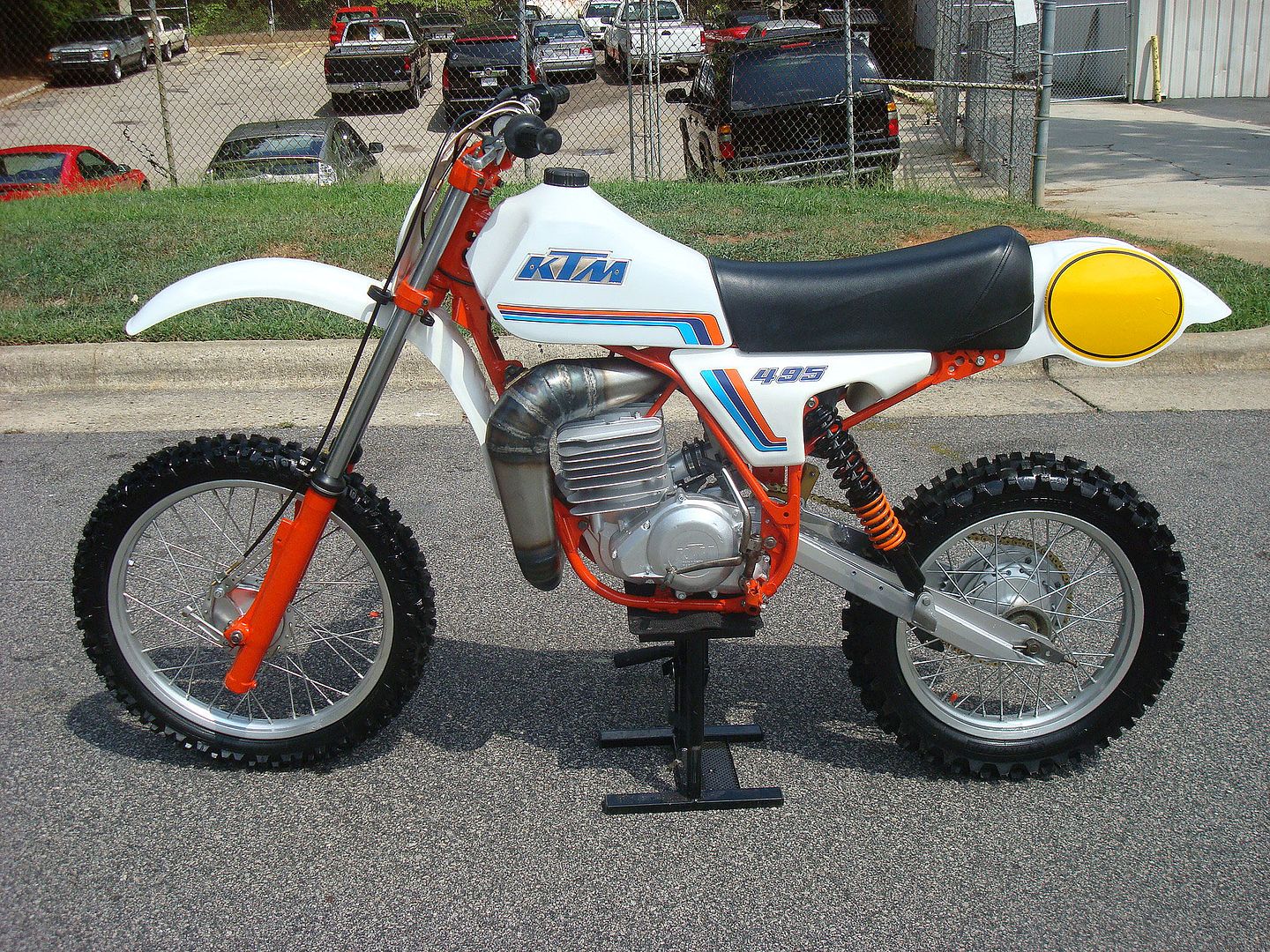
We'd heard about those Baja bikes hitting 115 mph or more, while some experts have flatly stated that no production motocross dirt bike will run over a hundred per. Even with the tallest possible gearing to be had.
Well sir, the arrival of a 495 KTM and a genuine maniac Six Days rider appeared to us to be the perfect combination. Rod Bush is the Service Manager of KTM, U.S.A., and has a pretty good track record to back him up. Three golds, a silver and a bronze. He's also the eleventh-ranked enduro rider in the country.
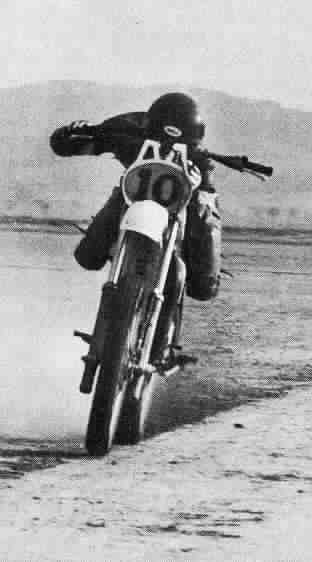
A 16-tooth countershaft sprocket was delayed from Austria, so we had to go with a 15-fang version. Internal changes were needed to make up for this. A 20-tooth fifth gear from a 390 enduro bike was slipped in. Primary drive was 31/79.The gearing at the rear was limited to 48 teeth. Not enough for what we had in mind. A YZ250G rear wheel was found to be a virtual slip-fit, just by making some simple spacers. This let us drop to a 44-tooth rear sprocket, which is just about worth one more tooth on the countershaft.
To play it safe, we also installed a gigantic 150.80 x 18 Metzeler, two-ply, nylon tire. This massive tire is almost 29 inches tall and noticeably dwarfs a 4.50 x 18 Metz. A larger tire is much like gearing a bike up. Rod felt that he could get some extra rpm out of the engine by changing the timing.
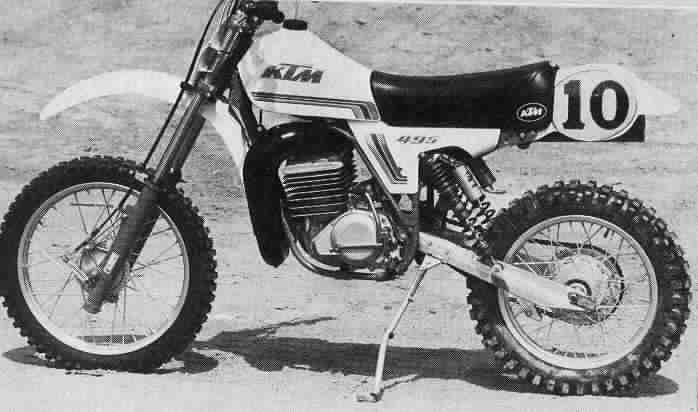
The deck height was changed to 1.4mm, from a normal height of .8 to .9mm. Intake and exhaust manifolds were carefully matched, but no porting was done. Carburetion was left standard. Ron ran premium gas with a 50:1 Duralube mix. Klotz Octane Booster was added to get rid of any possible detonation at the high engine speeds we'd be running at.
After the bike was thoroughly checked out and broken in, we headed out for famed El Mirage dry lake, home of many high-speed crazies. The lake was in reasonable condition, with a bit of mud and water at the edges. We had enough room for our needs. Two markers were set up and Rod took some initial passes. We checked all three stop watches and double-checked the distances.
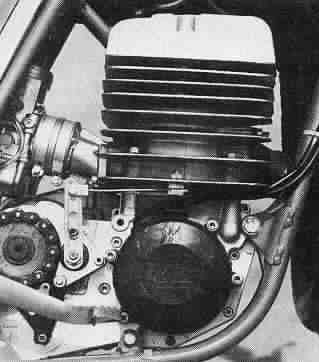
Our first dozen passes had us in the 108 to 110-mph range. Rod leaned out the main jet in the 40mm Bing carb and slipped into a set of Danaise road racing leathers and a full coverage helmet with a shield. He also felt he could get a greater speed with more distance available before the traps. Because of the limitations of the wet part of the lake, Rod had to try to get the bike up to a high speed on a bumpy fire road. We estimated his speed at near 90 before he got on the smooth lake bed. It worked! On his next pass Rod went over 120 mph!
More runs and a semi lay-down position got the speed even higher. Our best run of the day was 123.75 miles per hour! Astounding! We felt that even more speed potential was there if we'd have more room and taller gearing.
So, what's the point of all this? Basically, we wanted to deal in absolutes. The 495 KTM is representative of a new generation of super bikes. The 490 Maico spearheaded the effort and other manufacturers are girding their industrial loins for the battle to come.In a very dramatic way, a top-speed run is the ultimate dyno. Just how much does it have? What will she do? Make the motor try to punch a hole in the wind. Slap enough gears on it to force the engine to grunt, moan andshudder as hard as it can. What'll she do . . . indeed.
BACK TO THE TEST
Once we got all the high-speed stuff out of our system, it was time to test the KTM as a genuine, functional bike. A glance intimidates. The 495 is long and tall. The cold, white color is broken up with just enough touches of red and blue to make it look like a weapon, rather than a motorcycle. It's an angular beast. Just about the only things on the KTM that are round are the wheels. The rest of the bike appears to have been designed by an engineer addicted to a straight-edge ruler. From the shift side, the KTM engine appears normal. From the brake side, it's positively mammoth. Fins extend out well past the cases. The unpainted aluminum barrel and polished magnesium cases accentuate the angular lines.
If looks determined usage, the KTM495 would go around with a machine gun mounted on the bars. Tippy toes time. Sling a leg over the 495. Or, at least, try to. With an incredible 38.7-inch saddle height, the KTM has the distinction of being the tallest bike we've ever tested. Riders in the five-foot nine-inch range will need a milk crate. Once on the bike, the suspension settles a bit, making the ground barely in reach for a five-foot eleven-inch rider. You won't find any sag in the saddle. In fact, it appears to be made of plywood. That sucker is hard! It's also slippery. Sort of feels like someone put some Armor-All on it at the factory. On the plus side, the foam never sags and the saddle retains its shape. Long time KTM riders say they like the firm feel. Long-time KTM riders have also been known to howl at the moon on occasion.
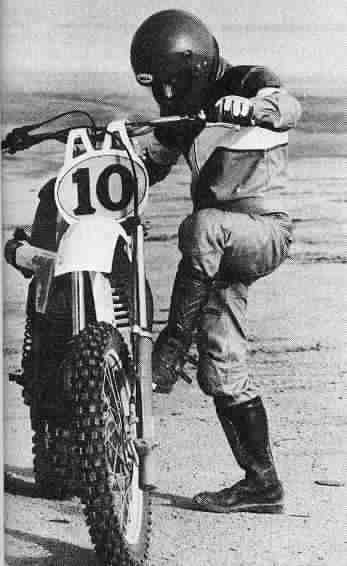
Fire it up, if you will. When cold, tickle the button on the Bing carb until gas slobbers over the cases (tsk, tsk), then, more often than not, one kick will get things stirred up. You'll hear surprisingly little mechanical clatter from the huge engine, even when cold. KTMs are made well and tolerances are on the tight side. Very little noise comes out of the exhaust, too. Especially for an open bike. Some of the "Penton" heritage about making quiet bikes still lingers. A new kickstarter tucks in a lot better than previous efforts. You can start the KTM in gear, but there's usually a hint of clutch drag that makes starting in neutral easier. Ahhh, yes. Neutral. Catch it if you can. Hard to find the little bugger. Impossible, with the engine running. It's easier to locate neutral going down from second, than up from low.
When the engine is warmed up, stuff it into gear (no graunching sound) and feed the clutch out. The 495 will lunge forward if you're not smooth with the clutch. You can feel the incredible power right away. Low gear, with stock gearing, is next to useless. Second-gear starts are childs' play, and third-gear starts are reasonable.A few trips through the gears and some fun playing with the throttle shows you that most of the power delivery is at midrange and up.
This is not to say that the 495 doesn't have plenty of low-end punch. It has plenty. But we're bound to make a thumbnail comparison to the 490 Maico. The 490 has more right off the very bottom of the rpm range, and has a thunderous midrange, but flattens out earlier than of the KTM is softer at lower revs, very strong early in the mid-range and absolutely violent in the upper mid-range to peak revs. You can still short-shift the 495 like any good Open Class bike, but if you want to rip the socks off the bike next to you, snap open the throttle at right around 4000 rpm and hang on for dear life.
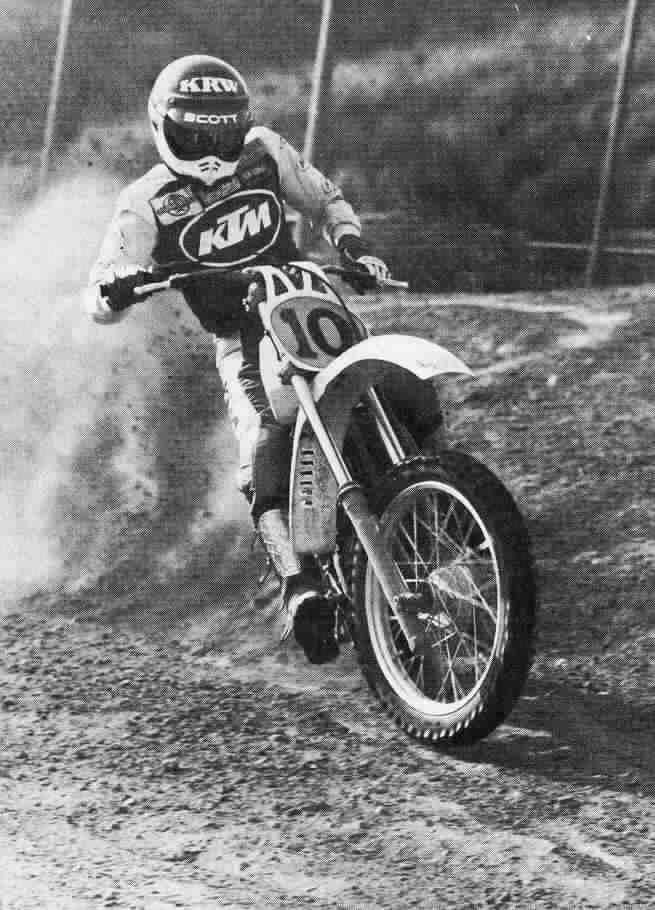
You say that motocross racing is nothing more than a short series of drag races from Point A to Point B? Sure. And the Titanic was just stopping for ice. The KTM belongs to an elite group of two bikes that will go from Point A to Point B much faster than the rider is ready for. You literally aim the front wheel in the desired direction and pull the trigger. Things happen quickly. First-time riders will overshoot corners grossly. Unwanted wheelies happen with regularity. But one thing is undeniable. The rush is there. The red-eyed, nostril distended, white-knuckled, puckered-butt rush is there! As you click through the gears, the landscape whistles by at an alarming rate. By the time fifth is engaged, you know that you're over your head. However, you'll do it again and again. Such is the nature of super bike addiction.
Because there's only one other machine in the super bike class, we must compare certain traits in the KTM to the Maico. The taller KTM does not turn as sharply as a Maico, but has greater high-speed stability. Part of this must be attributed to the tall stature, combined with a longish wheelbase. Take a Maico and a KTM through a sand wash in fifth gear, side by side, and the KTM rider can relax more. The bike tracks like an arrow. The Maico will hunt and shake a bit. Take the same two bikes and ride on a hard-packed track with tight turns. The Maico will carve a line under the KTM. Once dialed in, the KTM responds well. It's just that it takes a bit more muscle to snub it around than the big "M."
You might say that the KTM steers more with the rear wheel than the Maico. One must consider the Maico as a front wheel steering bike. With the 495, throttle and body movement are important and have more effect on directional changes, rather than merely sawing at the bars.
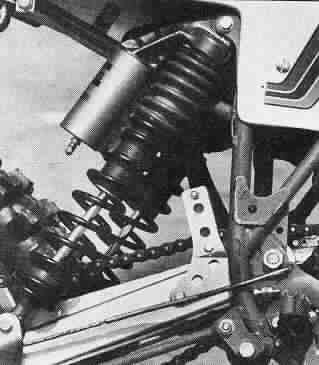
A pair of Ohlins shocks do the work at the rear. They're nestled in a beautiful aluminum swingarm. Action on our test bike was beyond reproach. We were never even tempted to mess with the preload. That's a nice feeling; just Jump on a bike and ride it — as is. Actual travel is 12.8 inches, which is just about the limit of current technology. Up front, you'll find a set of bright orange, Marzocchi, 38mm forks. We expected only average performance from these units, but, as the commercial goes, we are surprised! These ain't no downstream forks. Travel runs at 12.0 inches, even. We felt that the forks sagged a bit; we were tempted to add air caps to help firm things up, but instead we added about two ounces of oil to each leg. This firmed up the mid and late part of the stroke, but kept things soft and smooth on the first part.
Marzocchi engineers are convinced that forks needing a heavy air assist are flawed. Right now, most of the factory bikes are not running air, so their thoughts are right in line. Every once in a while, we'd hit a square-edged bump and a shudder would send a message to our wrists. Over normal ruts, bumps and whoopers, the Zokes worked well. Using a set of 43mm Yamaha forks as a "10," we'd have to rate the Marzocchis as a solid eight-plus. Some flex was experienced when the front end was dancing over rain ruts, but nothing alarming. Count on the sacking out after a while. Some will do it after four to five hours of operation; others after 20 or so hours. Don't bother replacing them with another set of Marzocchi springs. Investigate some Yamaha springs with a similar rate. We'll check into this and try to get some part numbers to you in the near future.
Clutch pull is on the stiff side. A Terry cable will help a bit. Clutch adjustment is critical. Sufficient free-play is essential to the plates staying alive. Brakes are excellent at both ends. Both drums and shoes are arced in at the factory. While not as powerful as Japanese brakes, the KTM stoppers are more predictable and easier to use. Wheels are primo; Sun rims; good hubs; reasonable spokes. Keep an eye on the spokes during the first 10 hours of riding, then forget about them, except for regular maintenance. Metzeler tires come stock on the KTM. Ours had a nylon, 21, two-plyup front and a rayon four-ply at the rear. Both are superb tires, with the nylon tires being a bit lighter.
By the way, we ran Metzelers for the high-speed run, with 28 psi in each wheel. The Metzeler folks told us that they've run a knobby at 130 mph on a test drum for 20 minutes with a 760 pound load before they had a knob chunk off. Impressive. We didn't care for the brake cable guide and installed a Pro Clamp up front for safety. All plastic is well-made, with the number plate/rear fender combo being particularly nice. No sense in covering up shocks and things with side plates.
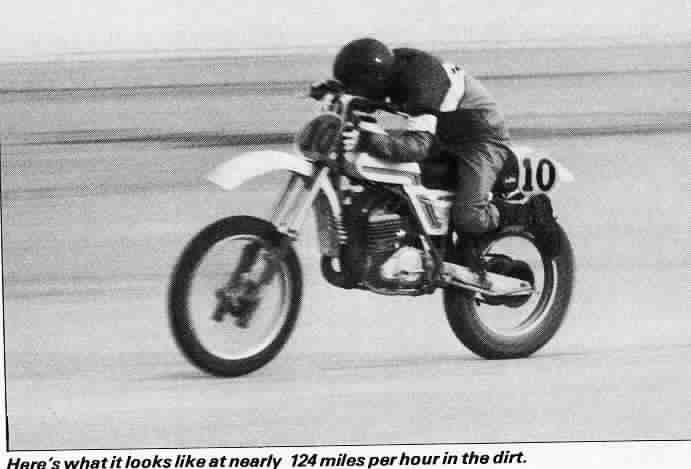
A 40mm Bing carb with a Powerpet is stock on the 495. While ours worked reasonably well, it was still far too sensitive to temperature changes to leave us happy. Jet a big Bing right in the morning, and by eleven o'clock, it's blubbering down low and detonating at midrange. No thanks. We'd preferto see something else more sophisticated on the KTM—like a brick with a hole drilled in it. Oh yes. We plan to try a Mikuni on the big 495 in the very near future. Keep posted on that.
The stock tank is 2.8 gallons, with an optional 2.2- and 3.5-gallon tank available. This means you can have some serious range on your KTM, should you need it. A KTM gas cap will fit on a Maico tank. Oddly, a Maico cap will often require a set of channel locks to get it off. Same with the KTM. Hmmm. New cases on the 495 shave about 10 pounds off of last year's engine. It's a tidy lower end, well protected by the frame rails, with nothing hanging out to catch a stray rock. Bars are a bit high and take some getting used to. There are two sets of risers under the bar clamps. This strikes us as a weak setup, but we never tweaked it, in spite of a few simple low sides. Shifting proved to be smooth, almost effortless. Just slap at the folding tip and ignore the throttle. Very much improved over the performance of the420 KTM.
A large muffler hangs off the rear of the pipe, stabilized by a bar attached to the frame. There must be a better way to mount this unit. The pipe itself could use better mounting brackets. It's hung the same way the 250 is, and we experienced cracks on the hangers after a period of time with the smaller bike. We can expect no less on the killer bike. A sensibly-designed and well-tucked in kickstand is mounted on the aluminum swingarm. Normally, we yank them off most bikes. We left ours on the KTM.
A well-protected air filter is housed in a large, easy-to-reach box. The saddle must be removed to gain access. Some folks keep asking us the unavoidable question: 490 or 495? Which way to go? If it were us, we'd have one of each in the garage, because both of them are so far ahead of the rest of the scampering big bike field.
But, here's the bottom line. If you just want to race motocross and the occasional GP, then the Maico is probably the bike for you. If you like to use your big bike for motocross, enduros and cross country, then the KTM is the big bike to buy. With little more than a skid plate and a speedo, the KTM is enduro and trail-ready. The Maico still owns the corners, but the KTM is more stable at warp speeds. In a drag race, through the gears, both bikes come out dead even. They cost the same and both machines have enough steam to scare you silly. Which one you end up with just might depend on how much you can brow-beat your local dealer.
Right now, the magic number is 123.75 miles per hour. Who can beat or even match that number? For now, the 495 is standing tall, in more ways than one.

We'd heard about those Baja bikes hitting 115 mph or more, while some experts have flatly stated that no production motocross dirt bike will run over a hundred per. Even with the tallest possible gearing to be had.
Well sir, the arrival of a 495 KTM and a genuine maniac Six Days rider appeared to us to be the perfect combination. Rod Bush is the Service Manager of KTM, U.S.A., and has a pretty good track record to back him up. Three golds, a silver and a bronze. He's also the eleventh-ranked enduro rider in the country.

A 16-tooth countershaft sprocket was delayed from Austria, so we had to go with a 15-fang version. Internal changes were needed to make up for this. A 20-tooth fifth gear from a 390 enduro bike was slipped in. Primary drive was 31/79.The gearing at the rear was limited to 48 teeth. Not enough for what we had in mind. A YZ250G rear wheel was found to be a virtual slip-fit, just by making some simple spacers. This let us drop to a 44-tooth rear sprocket, which is just about worth one more tooth on the countershaft.
To play it safe, we also installed a gigantic 150.80 x 18 Metzeler, two-ply, nylon tire. This massive tire is almost 29 inches tall and noticeably dwarfs a 4.50 x 18 Metz. A larger tire is much like gearing a bike up. Rod felt that he could get some extra rpm out of the engine by changing the timing.

The deck height was changed to 1.4mm, from a normal height of .8 to .9mm. Intake and exhaust manifolds were carefully matched, but no porting was done. Carburetion was left standard. Ron ran premium gas with a 50:1 Duralube mix. Klotz Octane Booster was added to get rid of any possible detonation at the high engine speeds we'd be running at.
After the bike was thoroughly checked out and broken in, we headed out for famed El Mirage dry lake, home of many high-speed crazies. The lake was in reasonable condition, with a bit of mud and water at the edges. We had enough room for our needs. Two markers were set up and Rod took some initial passes. We checked all three stop watches and double-checked the distances.

Our first dozen passes had us in the 108 to 110-mph range. Rod leaned out the main jet in the 40mm Bing carb and slipped into a set of Danaise road racing leathers and a full coverage helmet with a shield. He also felt he could get a greater speed with more distance available before the traps. Because of the limitations of the wet part of the lake, Rod had to try to get the bike up to a high speed on a bumpy fire road. We estimated his speed at near 90 before he got on the smooth lake bed. It worked! On his next pass Rod went over 120 mph!
More runs and a semi lay-down position got the speed even higher. Our best run of the day was 123.75 miles per hour! Astounding! We felt that even more speed potential was there if we'd have more room and taller gearing.
So, what's the point of all this? Basically, we wanted to deal in absolutes. The 495 KTM is representative of a new generation of super bikes. The 490 Maico spearheaded the effort and other manufacturers are girding their industrial loins for the battle to come.In a very dramatic way, a top-speed run is the ultimate dyno. Just how much does it have? What will she do? Make the motor try to punch a hole in the wind. Slap enough gears on it to force the engine to grunt, moan andshudder as hard as it can. What'll she do . . . indeed.
BACK TO THE TEST
Once we got all the high-speed stuff out of our system, it was time to test the KTM as a genuine, functional bike. A glance intimidates. The 495 is long and tall. The cold, white color is broken up with just enough touches of red and blue to make it look like a weapon, rather than a motorcycle. It's an angular beast. Just about the only things on the KTM that are round are the wheels. The rest of the bike appears to have been designed by an engineer addicted to a straight-edge ruler. From the shift side, the KTM engine appears normal. From the brake side, it's positively mammoth. Fins extend out well past the cases. The unpainted aluminum barrel and polished magnesium cases accentuate the angular lines.
If looks determined usage, the KTM495 would go around with a machine gun mounted on the bars. Tippy toes time. Sling a leg over the 495. Or, at least, try to. With an incredible 38.7-inch saddle height, the KTM has the distinction of being the tallest bike we've ever tested. Riders in the five-foot nine-inch range will need a milk crate. Once on the bike, the suspension settles a bit, making the ground barely in reach for a five-foot eleven-inch rider. You won't find any sag in the saddle. In fact, it appears to be made of plywood. That sucker is hard! It's also slippery. Sort of feels like someone put some Armor-All on it at the factory. On the plus side, the foam never sags and the saddle retains its shape. Long time KTM riders say they like the firm feel. Long-time KTM riders have also been known to howl at the moon on occasion.

Fire it up, if you will. When cold, tickle the button on the Bing carb until gas slobbers over the cases (tsk, tsk), then, more often than not, one kick will get things stirred up. You'll hear surprisingly little mechanical clatter from the huge engine, even when cold. KTMs are made well and tolerances are on the tight side. Very little noise comes out of the exhaust, too. Especially for an open bike. Some of the "Penton" heritage about making quiet bikes still lingers. A new kickstarter tucks in a lot better than previous efforts. You can start the KTM in gear, but there's usually a hint of clutch drag that makes starting in neutral easier. Ahhh, yes. Neutral. Catch it if you can. Hard to find the little bugger. Impossible, with the engine running. It's easier to locate neutral going down from second, than up from low.
When the engine is warmed up, stuff it into gear (no graunching sound) and feed the clutch out. The 495 will lunge forward if you're not smooth with the clutch. You can feel the incredible power right away. Low gear, with stock gearing, is next to useless. Second-gear starts are childs' play, and third-gear starts are reasonable.A few trips through the gears and some fun playing with the throttle shows you that most of the power delivery is at midrange and up.
This is not to say that the 495 doesn't have plenty of low-end punch. It has plenty. But we're bound to make a thumbnail comparison to the 490 Maico. The 490 has more right off the very bottom of the rpm range, and has a thunderous midrange, but flattens out earlier than of the KTM is softer at lower revs, very strong early in the mid-range and absolutely violent in the upper mid-range to peak revs. You can still short-shift the 495 like any good Open Class bike, but if you want to rip the socks off the bike next to you, snap open the throttle at right around 4000 rpm and hang on for dear life.

You say that motocross racing is nothing more than a short series of drag races from Point A to Point B? Sure. And the Titanic was just stopping for ice. The KTM belongs to an elite group of two bikes that will go from Point A to Point B much faster than the rider is ready for. You literally aim the front wheel in the desired direction and pull the trigger. Things happen quickly. First-time riders will overshoot corners grossly. Unwanted wheelies happen with regularity. But one thing is undeniable. The rush is there. The red-eyed, nostril distended, white-knuckled, puckered-butt rush is there! As you click through the gears, the landscape whistles by at an alarming rate. By the time fifth is engaged, you know that you're over your head. However, you'll do it again and again. Such is the nature of super bike addiction.
Because there's only one other machine in the super bike class, we must compare certain traits in the KTM to the Maico. The taller KTM does not turn as sharply as a Maico, but has greater high-speed stability. Part of this must be attributed to the tall stature, combined with a longish wheelbase. Take a Maico and a KTM through a sand wash in fifth gear, side by side, and the KTM rider can relax more. The bike tracks like an arrow. The Maico will hunt and shake a bit. Take the same two bikes and ride on a hard-packed track with tight turns. The Maico will carve a line under the KTM. Once dialed in, the KTM responds well. It's just that it takes a bit more muscle to snub it around than the big "M."
You might say that the KTM steers more with the rear wheel than the Maico. One must consider the Maico as a front wheel steering bike. With the 495, throttle and body movement are important and have more effect on directional changes, rather than merely sawing at the bars.

A pair of Ohlins shocks do the work at the rear. They're nestled in a beautiful aluminum swingarm. Action on our test bike was beyond reproach. We were never even tempted to mess with the preload. That's a nice feeling; just Jump on a bike and ride it — as is. Actual travel is 12.8 inches, which is just about the limit of current technology. Up front, you'll find a set of bright orange, Marzocchi, 38mm forks. We expected only average performance from these units, but, as the commercial goes, we are surprised! These ain't no downstream forks. Travel runs at 12.0 inches, even. We felt that the forks sagged a bit; we were tempted to add air caps to help firm things up, but instead we added about two ounces of oil to each leg. This firmed up the mid and late part of the stroke, but kept things soft and smooth on the first part.
Marzocchi engineers are convinced that forks needing a heavy air assist are flawed. Right now, most of the factory bikes are not running air, so their thoughts are right in line. Every once in a while, we'd hit a square-edged bump and a shudder would send a message to our wrists. Over normal ruts, bumps and whoopers, the Zokes worked well. Using a set of 43mm Yamaha forks as a "10," we'd have to rate the Marzocchis as a solid eight-plus. Some flex was experienced when the front end was dancing over rain ruts, but nothing alarming. Count on the sacking out after a while. Some will do it after four to five hours of operation; others after 20 or so hours. Don't bother replacing them with another set of Marzocchi springs. Investigate some Yamaha springs with a similar rate. We'll check into this and try to get some part numbers to you in the near future.
Clutch pull is on the stiff side. A Terry cable will help a bit. Clutch adjustment is critical. Sufficient free-play is essential to the plates staying alive. Brakes are excellent at both ends. Both drums and shoes are arced in at the factory. While not as powerful as Japanese brakes, the KTM stoppers are more predictable and easier to use. Wheels are primo; Sun rims; good hubs; reasonable spokes. Keep an eye on the spokes during the first 10 hours of riding, then forget about them, except for regular maintenance. Metzeler tires come stock on the KTM. Ours had a nylon, 21, two-plyup front and a rayon four-ply at the rear. Both are superb tires, with the nylon tires being a bit lighter.
By the way, we ran Metzelers for the high-speed run, with 28 psi in each wheel. The Metzeler folks told us that they've run a knobby at 130 mph on a test drum for 20 minutes with a 760 pound load before they had a knob chunk off. Impressive. We didn't care for the brake cable guide and installed a Pro Clamp up front for safety. All plastic is well-made, with the number plate/rear fender combo being particularly nice. No sense in covering up shocks and things with side plates.

A 40mm Bing carb with a Powerpet is stock on the 495. While ours worked reasonably well, it was still far too sensitive to temperature changes to leave us happy. Jet a big Bing right in the morning, and by eleven o'clock, it's blubbering down low and detonating at midrange. No thanks. We'd preferto see something else more sophisticated on the KTM—like a brick with a hole drilled in it. Oh yes. We plan to try a Mikuni on the big 495 in the very near future. Keep posted on that.
The stock tank is 2.8 gallons, with an optional 2.2- and 3.5-gallon tank available. This means you can have some serious range on your KTM, should you need it. A KTM gas cap will fit on a Maico tank. Oddly, a Maico cap will often require a set of channel locks to get it off. Same with the KTM. Hmmm. New cases on the 495 shave about 10 pounds off of last year's engine. It's a tidy lower end, well protected by the frame rails, with nothing hanging out to catch a stray rock. Bars are a bit high and take some getting used to. There are two sets of risers under the bar clamps. This strikes us as a weak setup, but we never tweaked it, in spite of a few simple low sides. Shifting proved to be smooth, almost effortless. Just slap at the folding tip and ignore the throttle. Very much improved over the performance of the420 KTM.
A large muffler hangs off the rear of the pipe, stabilized by a bar attached to the frame. There must be a better way to mount this unit. The pipe itself could use better mounting brackets. It's hung the same way the 250 is, and we experienced cracks on the hangers after a period of time with the smaller bike. We can expect no less on the killer bike. A sensibly-designed and well-tucked in kickstand is mounted on the aluminum swingarm. Normally, we yank them off most bikes. We left ours on the KTM.
A well-protected air filter is housed in a large, easy-to-reach box. The saddle must be removed to gain access. Some folks keep asking us the unavoidable question: 490 or 495? Which way to go? If it were us, we'd have one of each in the garage, because both of them are so far ahead of the rest of the scampering big bike field.
But, here's the bottom line. If you just want to race motocross and the occasional GP, then the Maico is probably the bike for you. If you like to use your big bike for motocross, enduros and cross country, then the KTM is the big bike to buy. With little more than a skid plate and a speedo, the KTM is enduro and trail-ready. The Maico still owns the corners, but the KTM is more stable at warp speeds. In a drag race, through the gears, both bikes come out dead even. They cost the same and both machines have enough steam to scare you silly. Which one you end up with just might depend on how much you can brow-beat your local dealer.
Right now, the magic number is 123.75 miles per hour. Who can beat or even match that number? For now, the 495 is standing tall, in more ways than one.




